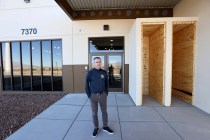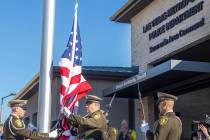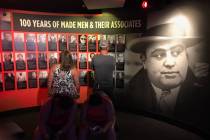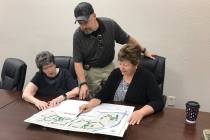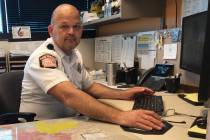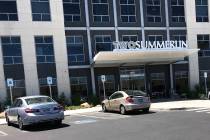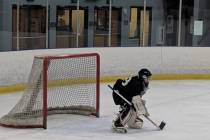Safety improvements on tap for Summerlin Parkway
You can easily point your finger at Summerlin Parkway as Nevada’s version of a modern-day “northwest passage.” While the roadway continues to be responsible for the development of Summerlin, it is also the jumping-off point for expansion into the far northern and western reaches of Las Vegas.
Considering that it didn’t exist as recently as a generation ago, the 5.3-mile parkway has boomed into one of the most heavily traveled intra-city arteries in Las Vegas.
And now, with the emergence of Downtown Summerlin, parkway usage has burgeoned to an all-time high, while it continues on a constant path of growth.
But with growth comes pains. For instance, there was a time when Summerlin Parkway was viewed by motorists as a pleasant and leisurely drive through a suburban area. But those days are gone. Progress and population growth have taken charge.
As a result, drivers more and more are finding the parkway to be a harrowing and increasingly stressful experience. The growth in traffic volume, coupled with an inevitable increase in accidents, especially during commuter hours, easily proves the point.
Still, the parkway has not only emerged as one of the major arteries in Las Vegas, it is increasingly vital to the continued development of Summerlin and points northwest. As such, long-awaited improvements intended to deal with the traffic volume and curtail the number or accidents have become a priority.
The good news is that “there are some major developments coming in the months ahead that will improve the flow of traffic along Summerlin Parkway and reduce the potential for accidents,” said Mike Janssen, assistant city traffic engineer.
The parkway is somewhat of an anomaly, since the city of Las Vegas owns more than 80 percent of the road. Sections of the remaining pieces belong to Clark County and the state of Nevada.
Janssen outlined three major developments that are in the works for the parkway. Foremost is a long overdue cable barrier that will be erected to reduce lane-change crashes. The barrier will extend along both the eastbound and westbound sides of the parkway from Buffalo Drive to the end of the freeway at the 215 Beltway, a distance of 4.4 miles on each side.
It will consist of heavy, flexible cable and was one of the major recommendations in a recent traffic study report prepared by Janssen’s office. The study was the result of an inordinate increase in fatalities and injuries along the roadway in recent years.
According to the report, “the primary purpose of a median barrier is to prevent cross-median collisions.” The study found “a high number of lane-departure crashes where a vehicle lost control and ended up in the median. This type of collision occurred 68 times in the last five years and resulted in four fatalities and 33 injuries.”
Another improvement will involve extending the HOV lane an additional 1,000 feet traveling westward, “to help ease maneuvering onto the parkway,” Janssen said. That’s the lane for multi-occupied vehicles that feeds off U.S. Highway 95 and onto Summerlin Parkway. The lane presently ends at Buffalo Drive.
The third enhancement will help reduce some of the heaviest traffic jams on the parkway. It’s the area leading to the westbound exit onto Rampart Boulevard. An auxiliary lane will be added to the parkway and will extend about 1,500 feet, from the Durango Drive exit to the Rampart exit. In addition, a third departure lane will be built to accommodate the new auxiliary lane, thus easing the logjam for drivers exiting at Rampart.
“The auxiliary lane will lead directly onto the exit ramp, and the third exit lane will help considerably,” Janssen explained. “It will help motorists depart from Summerlin Parkway more efficiently. That entire project will be a very significant improvement.”
When will all of this begin? After all, Janssen’s study report was released almost a year ago.
“We’re getting close,” he said, avoiding comment over the snail-like progress. Since three separate bureaucracies are involved — the city, county and state — you can expect delays.
But ever the optimist, Janssen anticipates that “we should reach the bid stage by this summer, and hopefully work will start on the three stages of improvement by the fall.”
Herb Jaffe was an op-ed columnist and investigative reporter for most of his 39 years at the Star-Ledger of Newark, N.J. His most recent novel, “Double Play,” is now available. Contact him at hjaffe@cox.net.








